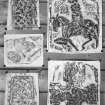Pricing Change
New pricing for orders of material from this site will come into place shortly. Charges for supply of digital images, digitisation on demand, prints and licensing will be altered.
Upcoming Maintenance
Please be advised that this website will undergo scheduled maintenance on the following dates:
Thursday, 9 January: 11:00 AM - 3:00 PM
Thursday, 23 January: 11:00 AM - 3:00 PM
Thursday, 30 January: 11:00 AM - 3:00 PM
During these times, some functionality such as image purchasing may be temporarily unavailable. We apologise for any inconvenience this may cause.
St Vigeans
Cross Slab (Early Medieval)
Site Name St Vigeans
Classification Cross Slab (Early Medieval)
Canmore ID 35573
Site Number NO64SW 3.21
NGR NO 6383 4294
Datum OSGB36 - NGR
Permalink http://canmore.org.uk/site/35573
- Council Angus
- Parish Arbroath And St Vigeans
- Former Region Tayside
- Former District Angus
- Former County Angus
St Vigeans 21 (St Vigianus), Angus, cross-slab fragment
Measurements: H 0.27m, W 0.23m, D 0.07m
Stone type: sandstone
Place of discovery: NO c 6384 4289
Present location: in St Vigeans Museum (HES).
Evidence for discovery: recorded in 1872 in re-use in the fabric of the church, and by 1903 it had been removed and placed in the porch. It was taken into St Vigeans Museum in 1960.
Present condition: broken and damaged.
Description
This fragment comes from the right-hand edge of a cross-slab and is carved in relief on both broad faces. Within a plain flat-band border, face A shows parts of the upper and right-hand arms of a cross, filled with diagonal key pattern, and linked by a segment of ring also with key pattern. The armpit was circular. Face C bears a simple spiral or coil in the corner, above the head of a bridled horse.
The fragment may be part of the same monument as St Vigeans 4.
Date range: ninth or tenth century.
Primary references: ECMS pt 3, 277; Geddes 2017, no VIG021.
Desk-based information compiled by A Ritchie 2017
Reference (1964)
NO64SW 3.21 6383 4294
No.21. Fragment of upright cross-slab. On the front face there are parts of two arms of a cross with their connecting rings. On the other side of the stone is the head of a reined horse, and a single spiral above it.
S Cruden 1964




















